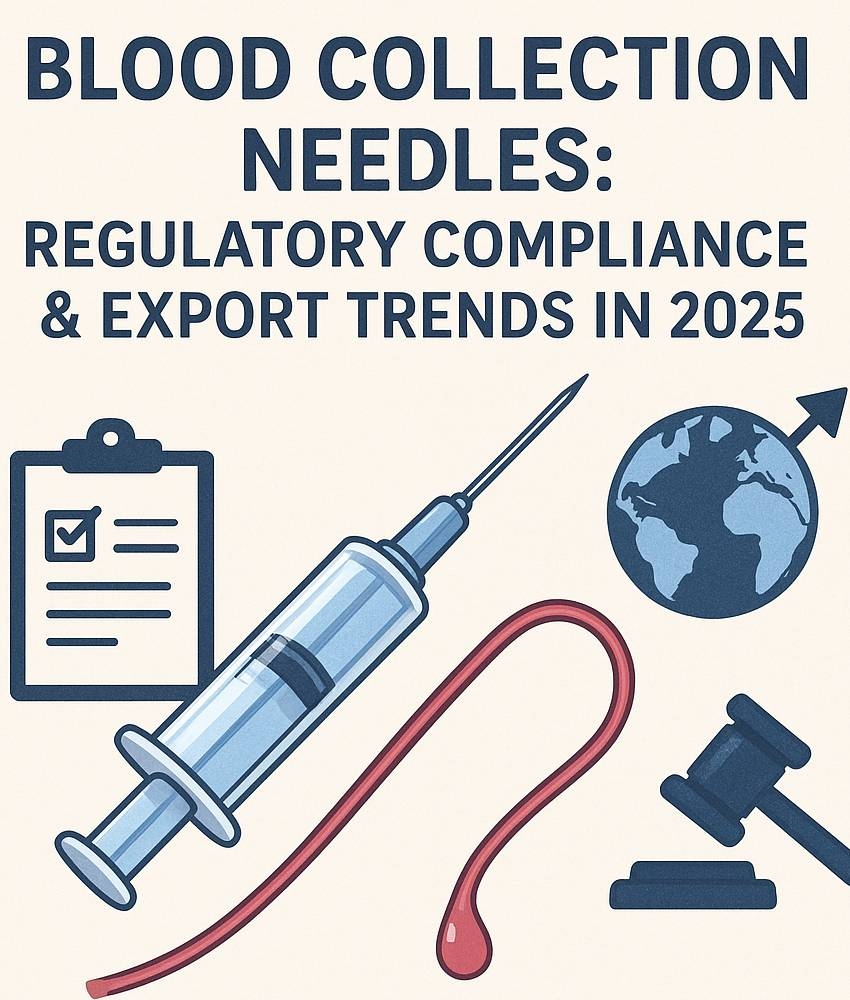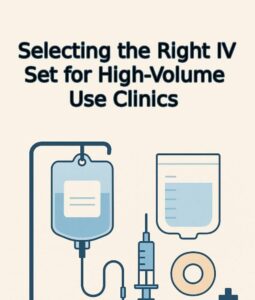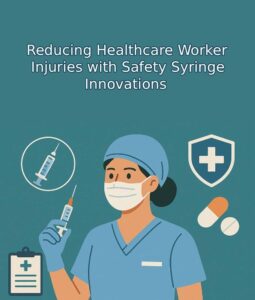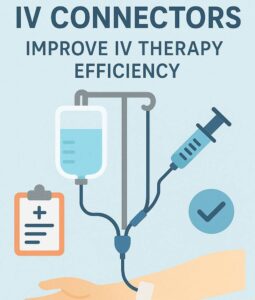Introduction: Global Shifts in Blood Collection Device Standards
As healthcare markets continue to globalize, compliance and international certifications have become more important than ever for any blood collection needle exporter, phlebotomy needle supplier, or manufacturer aiming to stay competitive. Achieving medical needle CE FDA certification isn’t just a requirement—it’s a strategic necessity in a post-pandemic world where demand for diagnostic tools is rising, and scrutiny from health authorities is intensifying.
From Europe to Southeast Asia, updated safety standards and trade agreements are reshaping how phlebotomy needles are designed, approved, and distributed. This article dives into the regulatory pathways, technical requirements, and emerging export trends every stakeholder must understand in 2025. Know more..
Understanding Blood Collection Needles and Their Global Role
Blood collection needles, often used in diagnostic and donation procedures, are essential components in healthcare systems worldwide. These sterile, single-use devices are typically made from surgical-grade stainless steel and connected to vacuum tubes or syringes for efficient sample collection.
A reputable phlebotomy needle supplier ensures:
- Painless vein access
- Sterile, trauma-free puncture
- Secure attachment to holders or tubes
- Reliable blood flow without hemolysis
For a blood collection needle exporter, ensuring these features align with international guidelines is a critical part of market success.
Core Regulatory Certifications: CE and FDA
To distribute globally, especially in premium markets like the EU and US, devices must meet both CE and FDA regulatory standards. Thus, every reliable blood collection needle exporter must secure and maintain the medical needle CE FDA status for product lines.
CE Marking (European Union)
The CE mark is mandatory for access to the EU market under the Medical Device Regulation (MDR 2017/745). For blood collection needles:
- Classification: Class IIa or IIb under invasive, transient-use category
- Required: Clinical evaluation, risk analysis, technical file submission
- Auditing: By a Notified Body (e.g., TÜV SÜD, BSI)
FDA Clearance (United States)
In the U.S., the FDA classifies most blood collection needles as Class II devices. To obtain approval:
- 510(k) premarket notification must be filed
- Performance testing, biocompatibility, sterility validation required
- Labeling must meet 21 CFR 801 standards
A qualified phlebotomy needle supplier or OEM partner with a strong compliance history will typically highlight their medical needle CE FDA credentials in product catalogs and trade shows.
Key Elements of a CE FDA-Compliant Medical Needle
When evaluating a phlebotomy needle supplier or reviewing technical specifications, it’s essential to look for the following compliance-driven features:
- Sterile Packaging: EO gas or gamma sterilization, ISO 11135 and 11137 compliant
- Material Safety: Surgical-grade stainless steel, latex-free, non-toxic plastic
- Needle Sharpness Testing: Per ISO 7864
- Hemolysis Control: Design prevents blood cell rupture
- Label Integrity: Resistance to smudging, meets global UDI requirements
A top-tier blood collection needle exporter will document these specs clearly to support cross-border inspections and customs checks.
Challenges in Exporting Blood Collection Devices
Despite increasing demand, exporting blood collection needles involves overcoming several hurdles:
1. Regulatory Complexity Across Markets
Countries like Brazil (ANVISA), Canada (Health Canada), and China (NMPA) have their own approval pathways. A medical needle CE FDA certification helps but does not guarantee access.
2. Logistics & Temperature Control
Even though blood collection needles are non-biological, packaging integrity must be maintained during shipping. Suppliers must provide:
- Impact-resistant outer cartons
- Cold-chain compatible packaging when needed
- Documentation in local languages
3. Changing Tariffs and Trade Agreements
Depending on regional partnerships (like EU-Vietnam FTA or U.S.-Mexico-Canada Agreement), duties and regulatory standards may fluctuate. A proactive blood collection needle exporter monitors these shifts to avoid delays or compliance failures.
Trends Shaping the Global Export Market
As we move deeper into 2025, several key trends are influencing how phlebotomy needle suppliers and blood collection needle exporters operate globally.
1. Demand Surge from Preventive Healthcare Programs
With increased focus on early detection, health systems are scaling diagnostic services, especially in India, Indonesia, and parts of Africa. This has led to larger tenders from both public and private institutions for certified medical needle CE FDA products.
2. Rise of OEM & Private Label Partnerships
More distributors are outsourcing manufacturing to Asia-based firms while branding needles under their own labels. A full-service phlebotomy needle supplier often supports:
- Custom packaging
- Branding
- CE/FDA compliance management
This trend expands reach while keeping capital investments low.
3. Sustainability in Medical Manufacturing
Buyers are demanding eco-conscious packaging and manufacturing. Recyclable packaging, reduced plastic usage, and carbon-neutral shipping are becoming new benchmarks for a globally responsible blood collection needle exporter.
Choosing a Reliable Phlebotomy Needle Supplier
For hospitals, clinics, or national health agencies, working with a qualified phlebotomy needle supplier is crucial for safety, reliability, and long-term cost-efficiency.
Key Supplier Evaluation Criteria:
- Compliance Certifications: Verified medical needle CE FDA credentials
- Quality Assurance Processes: GMP-certified production lines, ISO 13485 systems
- Production Capacity: Ability to scale without delays
- Customer Support: Multilingual documentation, post-sales service, training tools
Transparency is the hallmark of a dependable phlebotomy needle supplier—they’ll offer full access to regulatory files and third-party test reports.
Export Documentation and Legal Requirements
To export successfully, especially from manufacturing hubs like China or India, a blood collection needle exporter must provide:
- Certificate of Origin
- Bill of Lading and Packing List
- Free Sales Certificate
- CE Declaration of Conformity
- FDA Device Listing Information
- Sterility Reports & Biocompatibility Tests
Missing or incomplete documentation can lead to shipment rejection or delays at customs. A smart phlebotomy needle supplier automates documentation to streamline logistics.
Best Markets for Needle Exporters in 2025
1. Middle East & Africa (MENA)
Countries like Saudi Arabia, Kenya, and Egypt are modernizing healthcare infrastructure. Large government tenders prefer medical needle CE FDA suppliers.
2. Southeast Asia
Vietnam, Thailand, and Malaysia are sourcing directly from certified blood collection needle exporters to support new clinical lab rollouts.
3. Latin America
Mexico and Brazil are top importers but require ANVISA registration and local partnerships. Exporters must work with licensed distributors or representatives.
4. Eastern Europe
Poland, Romania, and Ukraine offer lower competition and growing demand, especially for OEM-labeled devices from reputable phlebotomy needle suppliers.
Innovation in Phlebotomy Devices
Cutting-edge blood collection needle exporter brands are developing smart features to align with digitized healthcare systems, including:
- Needle Shields: To prevent needlestick injuries
- Integrated Barcoding: For tracking and traceability
- Smart Flow Regulators: Ensure gentle blood draw, reducing sample degradation
These enhancements not only improve usability but also elevate regulatory compliance.
Frequently Asked Questions (FAQs)
1. What is the role of a phlebotomy needle supplier?
They manufacture or distribute sterile, compliant blood collection needles used in hospitals, labs, and donation centers.
2. Is CE or FDA certification more important for exports?
Both are crucial. CE opens EU markets; FDA is essential for U.S. exports. Together, they support global reach.
3. What makes a blood collection needle CE FDA compliant?
Sterility, safety testing, clinical validation, labeling standards, and packaging integrity.
4. How can I verify a supplier’s certifications?
Request official CE and FDA documentation, cross-check with public databases, and verify third-party lab test reports.
5. Which countries have the highest demand for blood collection devices?
India, Brazil, Saudi Arabia, Vietnam, and Egypt are key emerging markets in 2025.
6. How can exporters reduce delays at customs?
Prepare complete documentation, label accurately, and comply with each destination’s import protocols.
Conclusion: Navigating the Global Landscape with Compliance and Confidence
For any blood collection needle exporter, success in 2025 and beyond depends on mastering the balance between compliance, innovation, and market responsiveness. Whether you’re supplying diagnostic labs in Europe or hospitals in Southeast Asia, meeting medical needle CE FDA standards and partnering with a credible phlebotomy needle supplier are essential steps.
Stay informed, stay certified, and expand globally with confidence.






